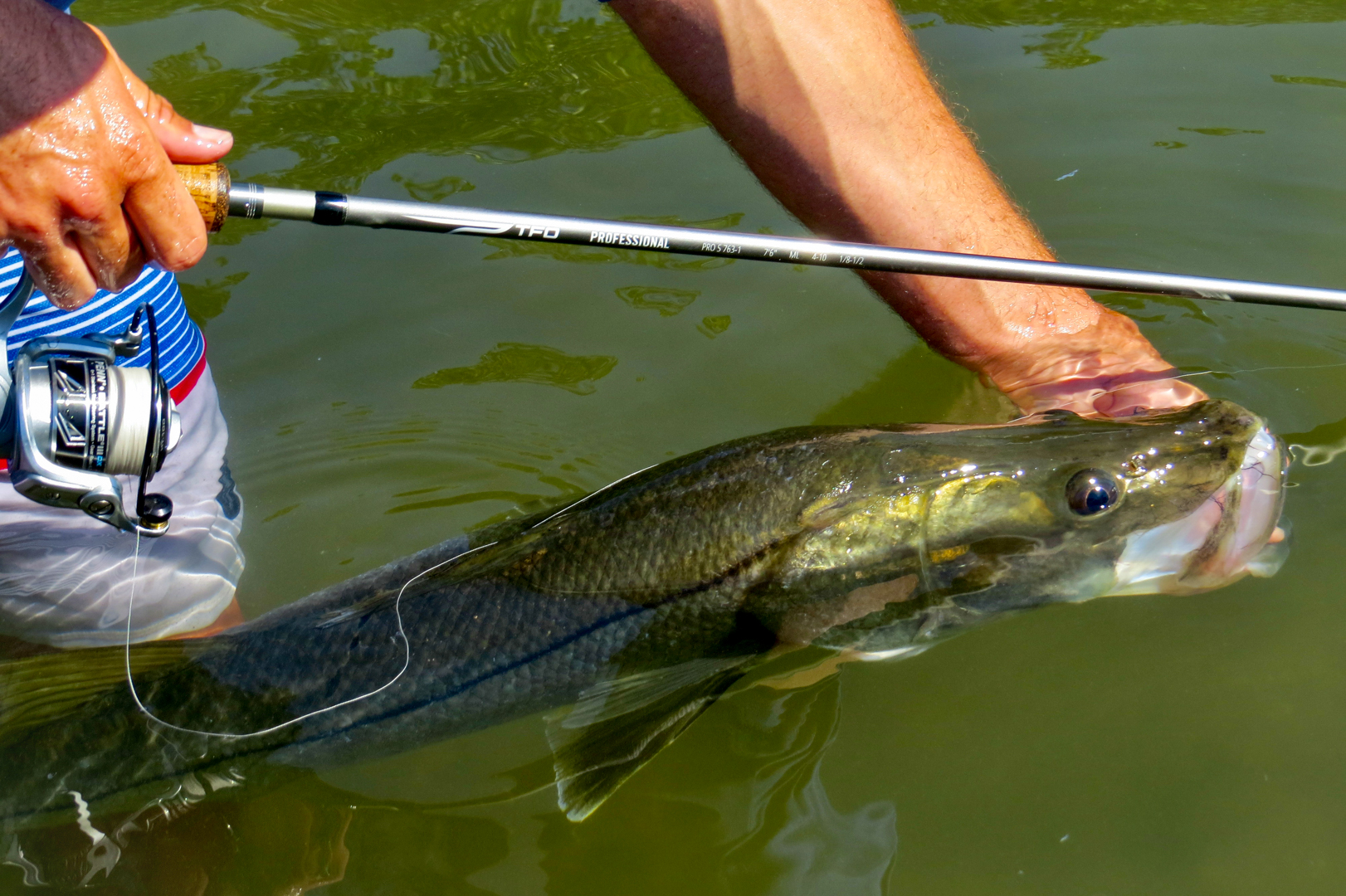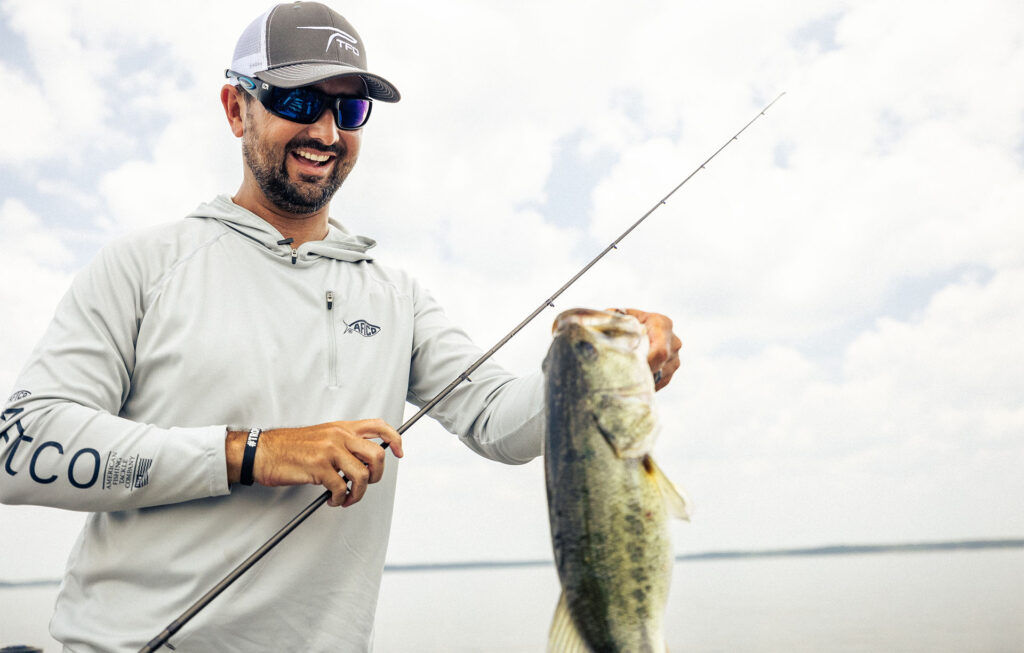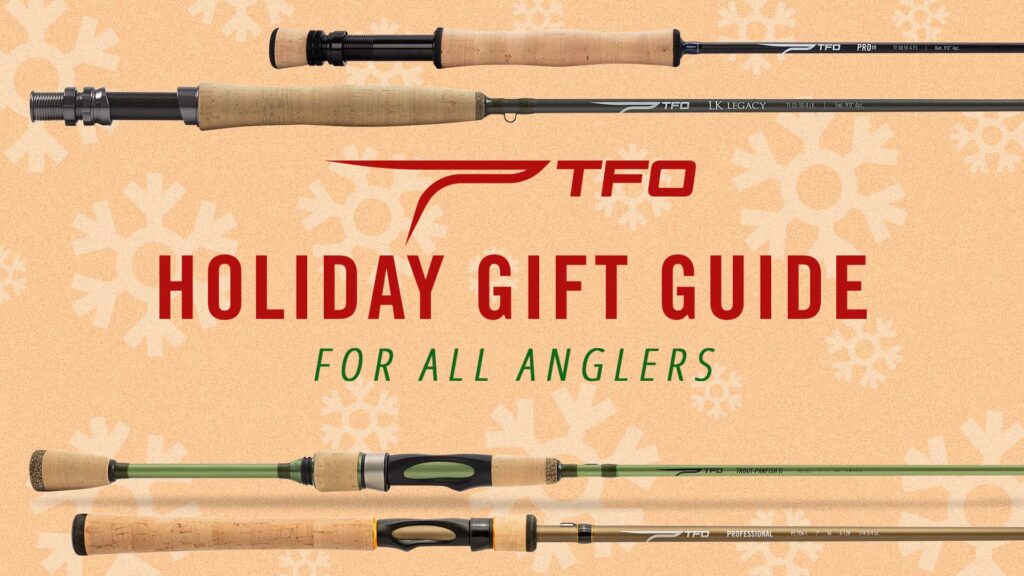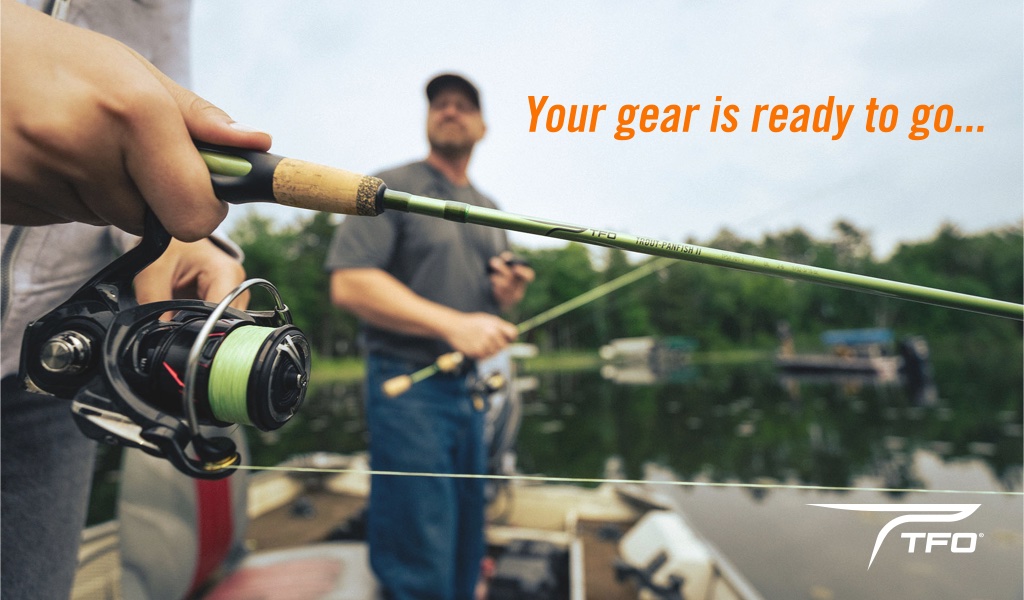I always say that bass fishing is about the bite, while saltwater is about the fight. Not to downplay the fight of a large bass, but the drag screaming from a saltwater fish is a different feeling altogether. No matter the type of water you are fishing that day, it’s essential to have the right gear.
The TFO Professional series of rods provides unrivaled versatility for a great rod to use in both freshwater and saltwater. This series provides an array of powers in both spinning and baitcasting models with a great all-purpose moderate-fast action. Along with their affordable price, the TFO Professional is the perfect rod for someone looking to expand a versatile collection of rods that covers both fresh and saltwater.

A nice Florida bass caught on the TFO Professional 7′ Heavy casting rod. // Photo: Max Moneuse
Located in west central Florida, I have been blessed with the opportunity to fish world class saltwater and freshwater fisheries. Most people don’t realize that saltwater and freshwater fishing have more in common than you may think. Between locating fish, finding the right bait to use, and connecting the two with your confidence styles, there are plenty of ways to make connecting the two fisheries more seamless.
Being versatile with your rods is only the start to converting between freshwater and saltwater, but you also must be flexible when finding fish and your techniques to catch them. One of the easiest ways to practice these two methods is to fish submerged grass flats. Predators in both salt and freshwaters stage to feed in grass flats very similarly. Look for holes, points, changes in bottom composition or thicknesses in grass is where you can find fish. You may not always throw the exact same baits in fresh and saltwater, but the fish are still staging in the same areas.
For the saltwater angler who is used to fishing hard lines of emergent vegetation such as mangroves or marsh grass where they target the points, cuts, and pockets – the same can be applied to freshwater – where anglers target hard lines of emergent vegetation such as bulrush, reeds, and Kissimmee grass. Bass are predators just like any other saltwater fish – they stage in various areas of cover throughout the year looking to hunt down and ambush their prey.

Photo: Max Moneuse
Bait selection is where things get interesting and might change a little bit. The biggest difference with baits, is that I find my saltwater tackle box to be much simpler when it comes to bait selection. Freshwater anglers will have crankbaits, spinnerbaits, chatterbaits, jerkbaits, jigs, and a vast selection of soft plastic style baits. There are several that can be used interchangeably between salt and freshwater.
The three most common baits I used between both fresh and salt are topwater baits, paddle tail swimbaits, and fluke style baits. A topwater walking bait in a current break, over grass, or along a hard edge of cover or vegetation can be quite productive in both scenarios. My main topwater setup stays the same between both salt and freshwater, a 6’ 6” TFO Professional baitcasting rod with a walking style topwater in white, chrome, chartreuse, or a combination of the three is the color I stick with nearly every time.

My main topwater setup – a 6’ 6” TFO Professional baitcasting rod. // Photo: Max Moneuse
The fluke and swimbait colors can vary much more between their use in either saltwater or freshwater, but a local tackle shop can help point you in the right direction for that body of water. Retrieval of these baits rarely changes between the disciplines and techniques. Even with different baits an angler may not be used to, the retrievals can be done closely. For example, a bass angler may bounce and hop a worm back to the boat, the same technique can be for a redfish with a fluke on a jighead. For the saltwater angler who is not used to a chatterbait, spinnerbait, or crankbait, think of it as you would fishing a swimbait that you are swimming through cover.
There are a lot of baits that work the same but provide a different presentation and/or profile to the fish. The biggest thing that a saltwater angler may not be used to is flipping and pitching into cover. An underhanded cast into thick vegetation, fallen trees, or lily pads is a great way to find big bass up shallow. The best way to learn flipping and pitching is to get out on the water and practice making the underhand pendulum motion with the release of the bait.

Flipping and pitching baits with the TFO Professional Series. // Photo: Max Moneuse
With the variety of baits out there, your rods play a significant role in presenting the bait properly. For the freshwater angler, picking up a few TFO Professional series spinning rods in a medium light to medium heavy power would be a great place to start for your saltwater rod selection. On the other side, the saltwater angler could start their freshwater rod selection by getting a TFO Professional series baitcasting rod in medium to heavy power depending on the cover in the lakes or rivers you plan to fish.

Making connections to big bass with the TFO Professional. // Photo: Max Moneuse
Lastly, don’t be afraid to find your own way to catch fish. Try throwing a chatterbait after a redfish or a popping frog for snook. A bass might eat your favorite twitch bait or bucktail jig. Don’t be afraid to try what you’re confident in freshwater in saltwater or vice versa. For example, I’m used to throwing weightless baits and letting them sink in 60 feet of water for a bite in the saltwater, so I started throwing weightless wacky rigs over deep points and brush for bass and it works great. I have thrown squarebill crankbaits along the edges of mangroves and caught plenty of snook, redfish, and snapper on them.
The biggest thing when converting between salt and freshwater is to just go fishing. Go to your local tackle shop and ask questions about that body of water. Use these tips to help you locate and catch fish, but always be open to learn no matter the salinity.

Blog author and TFO Ambassador Max Moneuse
Max Moneuse is a tournament angler and content creator based in Longboat Key, an island off of west central Florida. A three time Angler of the Year as a college angler at the University of North Florida, he is now fishing in Major League Fishing tournaments. An avid fisherman, Max travels across the southeastern United States on fishing excursions in both salt and freshwater. You can see Max’s adventures through his social media links below:
Instagram: @MaxMoneuse_Fishing
Youtube: Moose Juice Fishing
Tiktok: @MooseJuiceFishing







